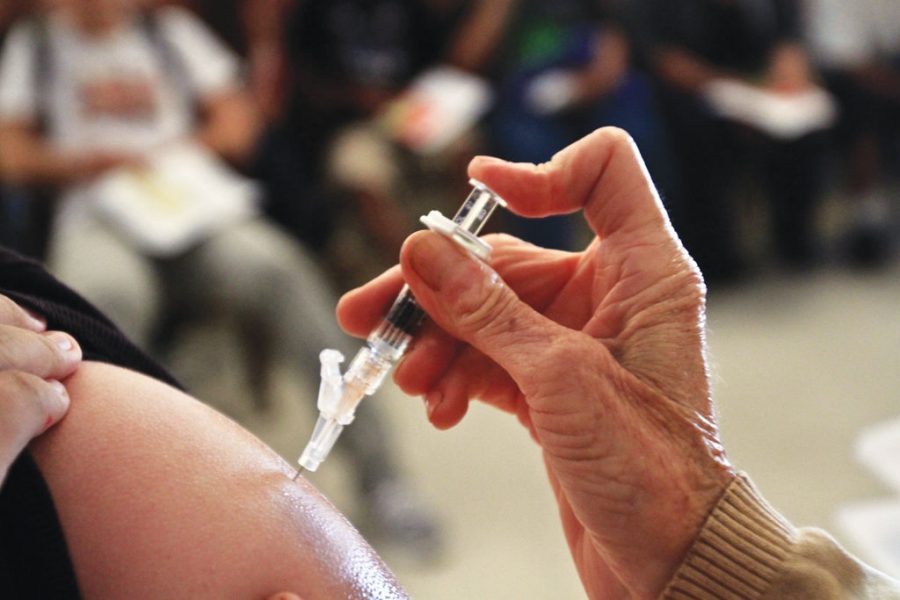Pitt researchers develop vaccine to fight respiratory virus
September 28, 2014
Pitt researchers developed a new vaccine that protects mice, and, hopefully, camels, against Middle East Respiratory Syndrome, or MERS, a viral respiratory illness spreading across the Middle East.
With enough funding, researchers hope to eventually find a vaccine to protect humans from the disease.
“In May 2013, more and more cases started happening in the Middle East, so we decided to design and manufacture this vaccine,” said Andrea Gambotto, an associate professor in Pitt’s Department of Surgery and senior author of the study.
MERS, which can infect humans and animals, causes “severe acute respiratory illness” including shortness of breath, cough and fever, according to the Centers for Disease Control and Prevention. About 30 percent of those with confirmed cases of MERS have died since the disease was first discovered in Saudi Arabia in 2012.
The team, made up of researchers from Pitt, the Netherlands, Saudi Arabia and Qatar, developed the vaccine in summer 2013.
“To make a vaccine is easy,” Gambotto said. “To make a real vaccine done through extensive testing is very complicated.”
Gambotto’s lab immunized a few mice and did some initial evaluation of the response in Pittsburgh. Gambotto then sent the sera samples from the immunized mice to Bart Haagmans’ lab in the Netherlands, where researchers performed immunological evaluations of the vaccine. They studied the activity against the virus and how well the vaccine neutralized it.
Subsequent studies looked for further evidence that scientists could use this vaccine to immunize camels, which scientists believe are the primary carriers of the disease in the Middle East. The researchers wanted to demonstrate that camels do not have antibodies to neutralize the virus on their own and that the vaccine would be able to infect camels’ cells without resistance.
“Therefore, future experiments in dromedary [Arabian or Indian] camels to test the immunogenicity and protective efficacy of these candidate vaccines are envisaged,” Haagmans said.
Gambotto’s Dutch collaborators were the first to show that a human and camel carried the same MERS virus.
“We are almost sure camels have an involvement in the disease,” Gambotto said.
However, Gambotto says it’s very unlikely that the camel is the only animal that is infected.
“There probably is another animal that will close the circle,” Gambotto said. “Usually, in this kind of disease, you have three animals. The third animal is probably something that lives in close quarters with camels.”
Until there is an epidemic outbreak, Gambotto said, the best approach now is to immunize animals.
“The camel seems to be one of the links, so we should immunize the camel,” Gambotto said. “There could be another animal involved, but if you stop this pingpong between the two animals, then you probably stop the disease.”
Gambotto compared MERS to Lyme Disease, through which the virus bounces between deer, ticks and humans.
Based on the team’s own work and what is known from other coronaviruses, vaccine candidates for MERS-CoV may need to induce antibodies to neutralize the virus at mucosal surfaces, or orifices, according to Haagmans.
“The approach taken by Andrea Gambotto may likely be successful, as the vaccine may be able to comply with both requirements,” Haagmans said.
The vaccine targets one antigen, an antibody generator, on the surface of the MERS virus because coronaviruses tend to be more stable on their surface antigens, Gambotto said. Nobody knows, though, if this virus will become more aggressive and evolve its antigenic profile. For now, the vaccine primes the immune system to detect the antigen and fight the virus.
One limitation of this vaccine technology in humans is their preexisting immunity to it. Because the vaccine developed is a hybrid, it contains strains from multiple viruses including SARS, MERS, influenza and Ebola. Since humans have an immunity to some of the viruses included in the vaccine, antibodies from a preformed immunity will neutralize the virus and render it ineffective.
Pitt’s Department of Surgery funded the beginning stages of the project.
“We finished [the] initial phase of evaluation, which is pretty preliminary but is also very promising,” Gambotto said. “The reality is that without money, you don’t go anywhere.”
The researchers are currently seeking more funding and a lab capable of handling work with camels.
“Although this vaccine technology is not very innovative, based on results obtained previously with similar vaccines, [it] may point to a successful future application,” Haagmans said.
Scientific, often medical, research like this is often a factor that continues to draw pre-med students to Pitt.
“The reason I wanted to come here was because of UPMC and all of the research that goes on there,” said Ellie Gaylord, a freshman pre-med student. “I knew that my professors would be doing research and that I’d be able to get hands-on experience here.”
When Kaitlyn Loh initially applied to schools, she never really considered Pitt, but changed her mind because of the scientific research at the University.
“I think research projects like this one show that Pitt is very underestimated sometimes, but a very smart and capable research institute that probably deserves more recognition than it gets,” Loh, also a freshman pre-med student, said. “I feel like people are under-informed about Pitt’s abilities.”








